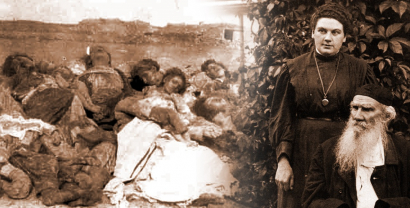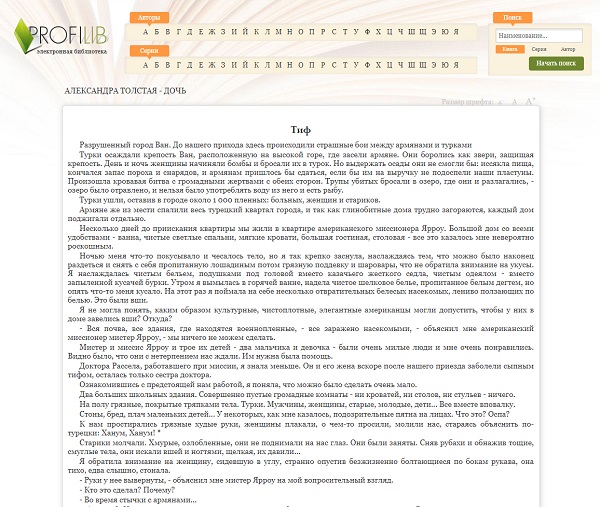Lev Tolstoy’s Daughter About Armenians’ Vandalism

The Azerbaijan State Translation Centre (AzSTC) has produced a documentary archival material “Lev Tolstoy’s daughter about the Armenians’ Vandalism” based on Alexandra Tolstaya’s memories, a daughter of the notable Russian writer Lev Tolstoy who was a living witness to the genocide procreated by Armenian vandals in 1915 in Van city, Turkey.
AzSTC intends to distribute the video footage with subtitles in English, Russian, Turkish, Persian, Arabic, Georgian, French, Ukrainian, Spanish and German languages among accredited foreign embassies and consulates to the Republic of Azerbaijan, relevant media bodies, global internet and social networks.
Alexandra Tolstaya (1884-1979), the youngest daughter of the great Russian writer Leo Tolstoy, is the founder of the famous Yasnaya Polyana Museum and the Tolstoy Foundation, as well as the author of books on art and journalism.
In 1915, Alexandra Tolstaya was sent to the Turkish city of Van by the Red Cross as a representative of the Russian Empire, where she witnessed the atrocities committed by Armenian militants against the Turks, and she wrote what she had seen in her diary.
‘... Wholly trashed Van city... Before our arrival, in this city there were terrible battles between Armenians and Turks.
The Turks laid siege to the mountain fortress occupied by the Armenians. The Armenians fought for the fortress like savages. Women made shells night and day and threw them at the Turks. They could not stand this situation for a long time, they ran out of food, they ran out of weapons and ammunition. If our Cossacks did not come to their aid just in time, the Armenians would undoubtedly surrender. There were bloody battles on both sides, and there were many casualties. The bodies of the dead were thrown into the lake ...
When the Turkish soldiers left Van, about 1000 people were captured, because they could not leave the city…’
* * *
‘... The Armenians set fire to the Turkish districts of the city; as the buildings made of clay were hardly flammable, they were burnt separately...’
* * *
‘... I was instructed on what I will do here ...
Two large school buildings. There are neither beds nor chairs in completely empty large rooms. Dirty, lifeless bodies covered with rags on the floor. They are Turks ... men, women, old and young people, children...
Babies’ groans, sobs, delusions ... Some have suspicious spots on their faces.
What is it? Leprosy?
Dirty, weak hands are reaching out to us ... Women shout crying, begging us for help: ‘Madam, Madam!’...
My eyes stuck to a woman, whose arms were strangely falling to her sides, as if she were dead. His slow moan was barely audible…
In response to my puzzled looks, Mr. Yarrow[1] explained to me the situation: ‘Her arms were pulled off.’
‘Who did it?' Why did they do it?’
‘During clashes with the Armenians’...
‘Did the Armenians do it? Why did they torture such an ordinary woman?’ - I asked in surprise. ‘But I have read in the newspapers that it was the Turks who committed atrocities here and massacred the Armenians. I do not understand anything ...
‘The massacre took place on both sides. Of course, in a military confrontation it can’t be otherwise. The enmity between Turks and Armenians has lasted for centuries. But here in Van we witnessed the atrocities of the Armenians that tarnished the good name of humanity. Armenians cut off women's breasts, pull their arms, hands off, break their legs ... I saw with my own eyes these inhuman atrocities, innocent victims ...’
|
Link: |
 |
AND OTHER...
-
 Book “Fuzuli’s Creativity” by Mir Jalal Out in Jordan
Book “Fuzuli’s Creativity” by Mir Jalal Out in Jordan
The book “Fuzuli’s Creativity” by the famous Azerbaijani writer and literary scholar Mir Jalal, which tells about the works of the brilliant Azerbaijani poet...
-
 Yusif Vazir Chamanzaminli’s Creativity in the Israeli Literary Magazine
Yusif Vazir Chamanzaminli’s Creativity in the Israeli Literary Magazine
“Artikl”, the popular Israeli literary magazine, has posted in Russian an excerpt from the novel “In the Crossfire” by Yusif Vazir Chamanzaminli, the outstanding...









